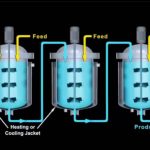Another type of ideal reactor is the tubular flow reactor operating isothermally at constant pressure and at steady state with a unique residence time. This type of reactor normally consists of a cylindrical pipe of constant cross-section with flow such that the fluid mixture completely fills the tube and the mixture moves as if it were a plug traveling down the length of the tube. Hence the name plug flow reactor (PFR). In a PFR, the fluid properties are uniform over any cross-section normal to the direction of the flow; variations only exist along the length of the reactor.
Additionally, it is assumed that no mixing occurs between adjacent fluid volume elements either radially (normal to flow) or axially (direction of flow). That is to say each volume element entering the reactor has the same residence time since it does not exchange mass with its neighbors. Thus, the CSTR and the PFR are the two ideal limits of mixing in that they are completely mixed and not mixed at all, respectively. All real flow reactors will lie somewhere between these two limits. Since the fluid properties vary over the volume of the reactor, consider a material balance on a section of a steady-state isothermal PFR, dL (see Figure 3.4.1):



Clearly, the space-time, T, in the ideal tubular reactor is the same as the residence time in the batch reactor only if volume changes are neglectable. This is easy to see from Equation (3.4.2) by substituting C;v for P; and recalling that for yolume changes v = y0(l + 8J)

Thus, if dv/ dVR = 0, then there is an analogy between T and t in a PFR and batch reactor, respectively [Equations (3.4.5) and (3.4.6)], and if dv/ dVR =1= 0, then comparison of Equations (3.4.7) and (3.4.6) shows that there is none.



